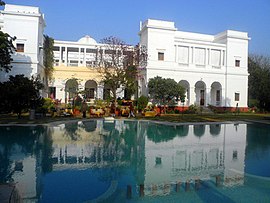Pataudi State
| Pataudi State | |||||||||
|---|---|---|---|---|---|---|---|---|---|
Princely State | |||||||||
| 1804–1948 | |||||||||
|
Flag | |||||||||
 Pataudi shown in Delhi Territory, south of Gurgaon, Imperial Gazetteer of India, 1908 | |||||||||
| Area | |||||||||
• 1901 | 135 km2 (52 sq mi) | ||||||||
| Population | |||||||||
• 1901 | 21,933 | ||||||||
| History | |||||||||
• Established | 1804 | ||||||||
• Accession to the Union of India | 1948 | ||||||||
| |||||||||


Pataudi State was a small princely state in India, established in 1804 during the East India Company rule in India.
The state formed a part of the Delhi Territory in the Ceded and Conquered Provinces. It was under the suzerainty of the Commissioner of Delhi. It had an area of 52 square miles and included one town, Pataudi, and 40 villages, ruled by the Pataudi family.
History
The state of Pataudi was established in 1804 by the
Maratha Empire, during the Second Anglo-Maratha War.[1] The family traces their origin to 16th century India, when their ancestors immigrated from present day Afghanistan to India during the period of the Lodi dynasty.[1]
The 8th Nawab, Iftikhar Ali Khan Pataudi, played cricket for both England and India and captained the latter. His son the last Nawab also captained the Indian cricket team.
At the end of the
Republic of India). In 1971, by virtue of the 26th amendment to the Constitution of India, the Government of India abolished all official symbols of princely India, including titles, privileges, and remuneration (privy purses).[2][3]
The former Pataudi Palace was a hotel for some time, but is now owned privately by Saif Ali Khan, the current patriarch of the family.
Rulers
Rulers bore the title of the Nawab.[4][5]
- Faiz Talab Khan (1804–1829)
- Akbar Ali Khan (1829–1862)
- Mohammad Ali Taqi Khan (1862–1867)
- Mohammad Mukhtar Husain Khan (1867–1878)
- Mohammad Mumtaz Husain Ali Khan (1878–1898)
- Mohammad Muzaffar Ali Khan (1898–1913)
- Mohammad Ibrahim Ali Khan (1913–1917)
- Mohammad Iftikhar Ali Khan (1917–1948)(1948-1952) (just as titular nawab after merging with India)
- Mansoor Ali Khan Pataudi (1952–1971) (Title abolished in 1971).
Demographics
| Religious group |
1901[6] | 1911[7][8] | 1921[9] | 1931[10] | 1941[11] | |||||
|---|---|---|---|---|---|---|---|---|---|---|
| Pop. | % | Pop. | % | Pop. | % | Pop. | % | Pop. | % | |
| Hinduism |
18,281 | 83.35% | 16,114 | 82.45% | 15,090 | 83.38% | 15,596 | 82.64% | 17,728 | 82.38% |
| Islam |
3,549 | 16.18% | 3,338 | 17.08% | 2,898 | 16.01% | 3,168 | 16.79% | 3,655 | 16.98% |
| Jainism |
103 | 0.47% | 82 | 0.42% | 109 | 0.6% | 105 | 0.56% | 128 | 0.59% |
| Christianity |
0 | 0% | 9 | 0.05% | 0 | 0% | 3 | 0.02% | 9 | 0.04% |
| Sikhism |
0 | 0% | 0 | 0% | 0 | 0% | 1 | 0.01% | 0 | 0% |
| Zoroastrianism |
0 | 0% | 0 | 0% | 0 | 0% | 0 | 0% | 0 | 0% |
| Buddhism |
0 | 0% | 0 | 0% | 0 | 0% | 0 | 0% | 0 | 0% |
| Judaism |
0 | 0% | 0 | 0% | 0 | 0% | 0 | 0% | 0 | 0% |
| Others | 0 | 0% | 0 | 0% | 0 | 0% | 0 | 0% | 0 | 0% |
| Total population | 21,933 | 100% | 19,543 | 100% | 18,097 | 100% | 18,873 | 100% | 21,520 | 100% |
| Note: British Punjab province era district borders are not an exact match in the present-day due to various bifurcations to district borders — which since created new districts — throughout the historic Punjab Province region during the post-independence era that have taken into account population increases.
| ||||||||||
See also
Notes
- ^ 1931-1941: Including Ad-Dharmis
References
- ^ a b The Hindu, Sunday, 3 Aug 2003 - Royal vignettes: Pataudi: The Afghan connection
- ISBN 978-0-88289-753-0, retrieved 6 November 2011 Quote: "A monarchy is only as good as the reigning monarch: thus it is with the princely states. Once they seemed immutable, invincible. In 1971 they were "derecognized," their privileges, privy purses and titles all abolished at a stroke" (page 91)
- ^ "The Constitution (26 Amendment) Act, 1971", indiacode.nic.in, Government of India, 1971, retrieved 9 November 2011
- ^ "Indian states before 1947 K-W". www.rulers.org. Retrieved 31 August 2019.
- ^ "Indian Princely States K-Z". www.worldstatesmen.org. Retrieved 31 August 2019.
- JSTOR saoa.crl.25363739. Retrieved 30 March 2024.
- JSTOR saoa.crl.25393788. Retrieved 30 March 2024.
- ^ Kaul, Harikishan (1911). "Census Of India 1911 Punjab Vol XIV Part II". p. 27. Retrieved 30 March 2024.
- JSTOR saoa.crl.25430165. Retrieved 30 March 2024.
- JSTOR saoa.crl.25793242. Retrieved 30 March 2024.
- JSTOR saoa.crl.28215541. Retrieved 30 March 2024.
External links
 Media related to Pataudi State at Wikimedia Commons
Media related to Pataudi State at Wikimedia Commons

